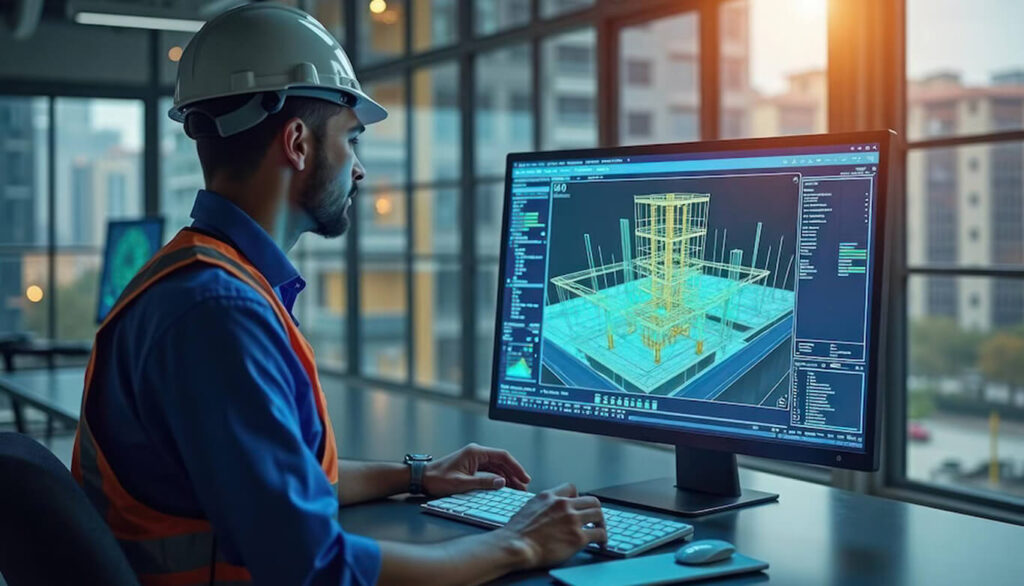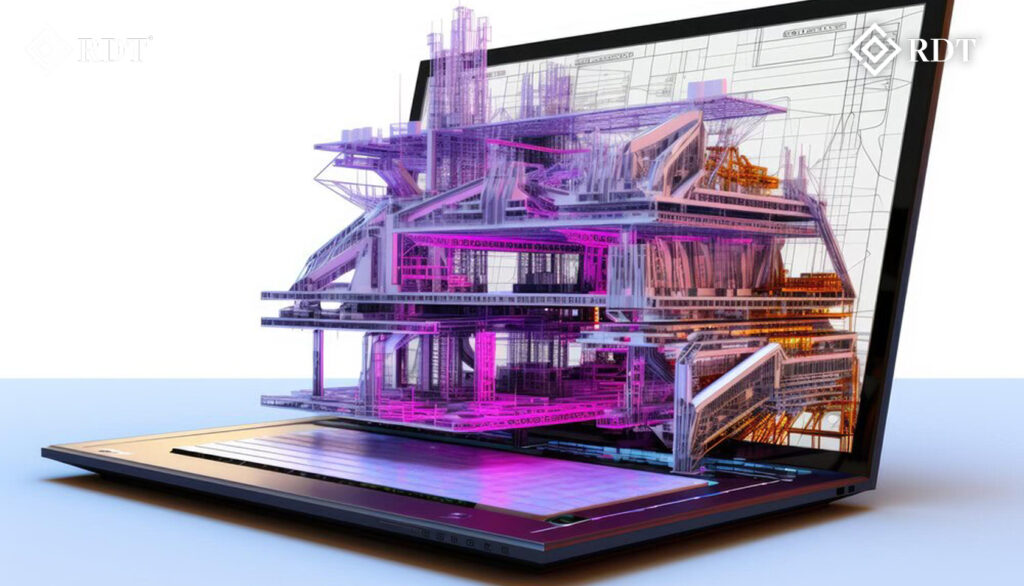The trajectory of residential architecture in 2025 is characterized by an intricate interplay of digital twin technology, parametric design algorithms, and data-driven decision-making. For enterprise-level firms navigating this evolving landscape, the reliance on BIM-integrated ecosystems is no longer a choice but a necessity.
This shift demands an advanced understanding of computational design models and multi-disciplinary coordination platforms. RDT Technology provides BIM solutions that facilitate seamless collaboration across architectural, structural, and MEP domains, offering an unparalleled advantage in the residential sector.
This technical examination delves into the key trends shaping the future of residential design, highlighting how BIM-driven workflows are empowering architects to achieve unprecedented design precision.
1. Multi-Dimensional BIM for Predictive Analysis and Simulation

The evolution of 5D and 6D BIM extends beyond traditional visualization, offering real-time predictive insights into project performance. For large-scale residential developments, this capability provides a clear competitive advantage.
5D Cost Estimation and Variance Analysis
- AI-Driven Quantity Takeoffs: Leveraging advanced neural networks to generate automated quantity takeoffs, architects can analyze cost implications using historical data.
- Market-Linked Cost Simulations: BIM platforms are integrated with real-time material pricing APIs, providing dynamic cost projections and scenario planning.
- Variance Control Algorithms: Algorithms cross-reference design iterations against the initial budget, detecting financial deviations and suggesting corrective actions.
6D BIM for Asset Lifecycle Management
- Predictive Maintenance Schedules: IoT sensor data embedded into Digital Twins facilitates anomaly detection using machine learning models.
- Sustainability Compliance: Dynamic Life Cycle Assessment (LCA) algorithms analyze material choices for embodied carbon reduction, ensuring regulatory compliance.
- Post-Occupancy Performance Analysis: AI-powered simulations generate insights on energy consumption patterns, providing actionable recommendations.
RDT Technology’s BIM solutions integrate these multi-dimensional models within a centralized ecosystem, driving cost transparency and operational resilience.
2. Generative Design and Computational Modeling for Adaptive Residential Spaces
Generative design, empowered by parametric algorithms, has transitioned from conceptual experimentation to real-world application. Architects can now generate thousands of spatial iterations, refining designs using data-led decision frameworks.
Computational Design Workflow
- Algorithmic Form-Finding: Using tools like Grasshopper and Dynamo, architects apply genetic algorithms to optimize massing and façade systems.
- Multi-Objective Optimization (MOO): Custom scripts execute simultaneous performance analyses, balancing daylighting, ventilation, and structural integrity.
- Topology Optimization: Finite Element Analysis (FEA) algorithms minimize material usage while maintaining load-bearing capacity.
Scenario-Based Iteration and Evaluation
- BIM-Embedded Environmental Simulations: Solar exposure, wind flow, and thermal comfort simulations inform design adjustments.
- Agent-Based Occupancy Modeling: Predictive algorithms simulate occupant behavior under various layouts, refining spatial organization.
- Real-Time Design Feedback: Integrated parametric models provide instant insights into the energy, material, and cost implications of design choices.
Through RDT Technology’s BIM-driven parametric design capabilities, architects unlock unprecedented agility in residential project execution.
3. AI-Powered Design Validation and Compliance Automation

The next frontier in residential design involves AI-driven validation engines that continuously assess designs against industry regulations and constructability constraints. This eliminates downstream inefficiencies, enhancing first-time design accuracy.
Cognitive Design Auditing
- Rule-Based Model Checking: Platforms like Solibri and Navisworks apply compliance algorithms to validate structural, MEP, and architectural models.
- Generative AI for Error Detection: Large language models (LLMs) analyze design documents, flagging ambiguities and recommending corrections.
- Predictive Structural Integrity Analysis: AI algorithms simulate load distribution, identifying vulnerabilities under stress scenarios.
Smart Compliance Monitoring
- Regional Code Libraries: BIM platforms integrate region-specific code libraries for automated design checks.
- Energy Compliance Algorithms: AI models cross-reference energy performance simulations against regional green building codes, ensuring carbon neutrality.
- Iterative Feedback Loops: Machine learning algorithms adapt based on historical project outcomes, refining future recommendations.
With RDT Technology’s AI-driven compliance systems, architects mitigate regulatory risks and accelerate design approvals.
4. Net-Zero and Decarbonization Through Advanced Energy Modeling

Achieving net-zero residential developments by 2025 demands rigorous BIM-integrated energy modeling. Advanced energy simulation engines evaluate the cumulative impacts of building orientation, envelope design, and material selection.
Hybrid Energy Simulation Techniques
- Thermal Bridge Analysis: Using Finite Volume Methods (FVM) and Computational Fluid Dynamics (CFD), architects detect thermal anomalies.
- Daylight and Solar Gain Simulations: Parametric BIM models optimize window-to-wall ratios (WWR) to balance daylighting and heat gain.
- Climate-Adaptive Façade Design: Responsive façade systems integrated into BIM platforms adjust shading elements based on real-time solar radiation data.
Embodied Carbon Reduction Strategies
- Material Lifecycle Simulations: Cradle-to-grave analyses using tools like One Click LCA quantify embodied carbon across the supply chain.
- Circular Economy Integration: BIM models suggest material reuse and recycling pathways, reducing construction waste.
- Carbon Offsetting Simulations: AI models propose effective carbon offsetting strategies, aligning with net-zero goals.
RDT Technology’s energy modeling solutions provide architects with actionable insights to achieve regulatory compliance and exceed sustainability targets.
5. Digital Twins and Predictive Facilities Management
In 2025, architects are leveraging Digital Twins as virtual replicas of residential projects. Enhanced by real-time sensor data and AI algorithms, these models deliver continuous operational insights.
Twin-Enabled Operational Intelligence
- Predictive Maintenance Analytics: Sensor-equipped systems predict HVAC, plumbing, and electrical failures using failure mode analysis.
- Occupancy-Driven Energy Optimization: Digital Twins analyze occupant behavior patterns, dynamically adjusting energy consumption.
- Automated Safety Simulations: Real-time data models simulate emergency scenarios, generating optimized evacuation routes.
AI-Augmented Decision Support
- Asset Performance Benchmarking: Comparative analysis using regional datasets identifies inefficiencies in building performance.
- Lifecycle Cost Optimization: Predictive algorithms recommend cost-saving interventions based on historical maintenance data.
- Real-Time Stakeholder Collaboration: Digital Twins act as a Single Source of Truth (SSOT) for multi-disciplinary collaboration.
Through RDT Technology’s advanced Digital Twin solutions, architects transition from static design roles to proactive operational management.
Conclusion
As we move into 2025, enterprise-level residential projects demand highly sophisticated design methodologies. The convergence of AI-driven BIM, generative algorithms, and Digital Twin technologies empowers architects to deliver projects that are smarter, more sustainable, and operationally efficient.
RDT Technology is your trusted partner in this evolution. From predictive design optimization to lifecycle management, our comprehensive BIM solutions equip architects with the tools to lead the future of residential design.
Discover how RDT Technology can transform your next project at https://rdttech.co/contact/.





